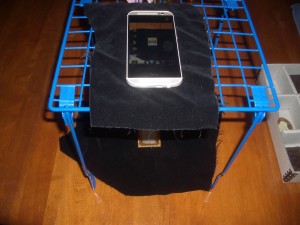Digitizing My Daguerreotypes
Since I don’t have any research at a point that I can write about it, I thought I would put together what I have learned about using my cellphone camera to digitize a picture or document and my trying the system out on some daguerreotypes.
I am very lucky in having a small (I think the number is 32 or 36) collection of family daguerreotypes. For several years now I have been periodically thinking about how to protect them in storage and how to digitize them without harming them. For now at least I solved the storage issue with an archival carton and trays that fit inside (made for storing other objects but with dividers making sections about the right size for one of the cased images).
I still have trouble with the distinction between a daguerreotype and an ambrotype, and am not sure I can reliably tell the difference (they are two different methods of producing a photographic image) and I think that at least some of what I have are ambrotypes. There is also some possibility that there is a cased tintype or two as well. Nonetheless, my concerns are the same in terms of protecting in storage and in terms of digitizing. These are unique original images, either printed on a silver plate or on glass, or possibly on iron.
If you go searching on the Internet about digitizing daguerreotypes, there is a fair amount of opinion and information, although you have to dig some to find any real detail about how to do it. I gather some people have a way to use a scanner and others use cameras. I decided to try combining what I discovered about using my cellphone to photograph things like business cards and documents with the cell phone (or iPad). It is an ingenious concept that works very well for many documents and pictures.
Some time ago I ran across a genealogy blog (perhaps reported on a Facebook group) that posted a simple technique that seemed like even I could use it. If you’re interested in what I think is the first report of using this method, it is here. The basics involve a wire mesh locker shelf which has holes about an inch across and which stands about a foot high. You simply place your cell phone or iPad with its camera directly over an opening and put the item to be photographed or scanned below it. Both blogs I just mentioned show clear pictures of the set-up. I particularly like the genealogist’s refinement of using the voice command to take the picture, so you don’t have to touch the camera possibly creating movement.
There are some limitations to using this particular method over a standard copy-stand. You cannot use a camera (unless it doesn’t have an extending lens) so you are restricted to what your phone or tablet can do. Likewise, the height above what you are copying is fixed, so you have to use the camera’s zoom to focus on smaller objects and you can’t copy oversize books, pages or pictures. I have a much shorter rack that is similar, sitting about 3 inches above the surface which is good for small images (business cards for example).
 When I started to test this set-up with my daguerreotypes, I found that even in daylight with no flash I was getting reflections because of the glass coverings. So then I remembered the advice to use a piece of cardboard covered with black velvet and a hole for the lens, so I dug out a couple of scraps of black velvet (I have lots of scraps because I usually don’t throw pieces away when I have made something). And voila! This seems to work well and now all I have to do is figure out which to use the short stand for and which to use the taller one for. This is what my set-up looks like with the taller stand.
When I started to test this set-up with my daguerreotypes, I found that even in daylight with no flash I was getting reflections because of the glass coverings. So then I remembered the advice to use a piece of cardboard covered with black velvet and a hole for the lens, so I dug out a couple of scraps of black velvet (I have lots of scraps because I usually don’t throw pieces away when I have made something). And voila! This seems to work well and now all I have to do is figure out which to use the short stand for and which to use the taller one for. This is what my set-up looks like with the taller stand.
Having at least temporarily figured out a way to digitize the collection as it is, I plan to eventually contact the Northeast Document Conservation Center which is conveniently located not too far from me about whether they can advise me about cleaning, preserving, more professionally digitizing, etc. this collection. I have also joined the Facebook group for The Daguerreian Society and am enjoying learning and seeing many different images. I don’t know that I will join those who collect them as objects but I do love having my collection of family images.

Leave a Reply